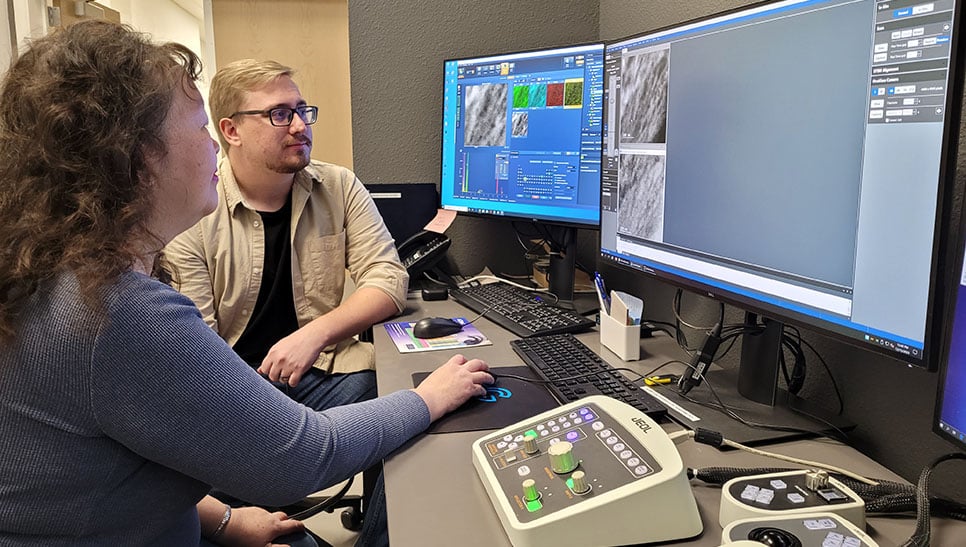Two Minority Serving Universities Advance ChemCatBio Research Priorities Through New Funding
Catalyst deactivation and slow computational research methods are recognized barriers to moving catalyst-driven bioenergy technologies from discovery to scale-up rapidly. But researchers are closer to mitigating both challenges thanks to two university-led projects in partnership with the Chemical Catalysis for Bioenergy Consortium (ChemCatBio).
The University of New Mexico and University of Maryland, Baltimore County, were awarded funding from the U.S. Department of Energy Bioenergy Technologies Office and the Minority Serving Institution STEM Research & Development Consortium as part of a ChemCatBio funding call. The funding partnership aims to reduce barriers of entry for minority serving institutions and increase bioenergy research collaboration.
According to ChemCatBio Director Josh Schaidle, the projects are part of a consortium strategy to synchronize catalyst innovation and diversity, equity, and inclusion goals.
“We are excited to partner with both universities and tap the unique expertise they bring to addressing catalyst deactivation and speeding catalyst discovery,” he said. “These diverse institutions, people, and perspectives are essential to realizing the vision of ChemCatBio, which is the rapid decarbonization of our economy.”
The following sections summarize both projects.
University of New Mexico—Developing Single-Atom Catalysts to Overcome Deactivation Challenges

Graduate student Jesse Larence and Research Assistant Professor Hien Pham analyze single atom catalysts developed at the University of New Mexico. Photo courtesy of UNM.
Collaborators:
- Abhaya Datye, Distinguished Regents’ Professor
- Jesse Larence, graduate student
- Hien Pham, research assistant professor
Catalyst deactivation reduces the durability and lifetime of catalysts critical for emerging bioenergy processes, including ChemCatBio technologies for upgrading ethanol into sustainable aviation fuel. A project led by faculty and students at the University of New Mexico’s Department of Chemical and Biological Engineering is exploring a process for developing catalysts with coatings of atomically dispersed reactive metals, which could help alleviate deactivation caused by oxidation.
“We have learned that if I convert nickel to nickel oxide, it's no good as a hydrogenation catalyst; you have to activate it by hydrogen reduction,” explained Abhaya Datye, who is the principal investigator. “However, when that nickel is dispersed atomically, it's now composed of single atoms of nickel and it's a very different species—It is formally in an oxidized state, but it will still do the hydrogenation, which is remarkable.”
This catalyst is resistant to deactivation caused by oxidation and forms the basis for developing new catalysts for ChemCatBio.
Although the team is evaluating catalysts with nickel, they will ultimately apply those findings to copper-based catalysts, which are primarily used in ethanol upgrading processes. Datye said this approach has the potential to avoid persistent oxidation issues, provide better thermal stability, and even provide different selectivity.
University of Maryland, Baltimore County—Applying a Novel Symbolic Regression To Speed Up Surface Chemistry Simulations

From left: Tyler Josephson, Kianoush Ramezani Shabolaghi, Samiha Sharlin, Charishma Puli, and Fariha Agbere. Photos courtesy of Tyler, Kianoush, Samiha, Charishma, and Fariha, respectively.
Collaborators:
- Tyler Josephson, assistant professor
- Kianoush Ramezani Shabolaghi, chemical engineering Ph.D. candidate
- Samiha Sharlin, Ph.D. candidate
- Charishma Puli, data science M.S. student
- Fariha Agbere, chemical engineering B.S. student
ChemCatBio researchers are developing methods for upgrading biomass into a feedstock of mixed olefins, which can be upgraded into energy-dense sustainable aviation fuel using zeolite catalysts. However, questions remain on how the molecular shape of the catalyst—especially the porosity of the catalyst—affects the efficiency of those reactions.
In the past, quantum chemistry has been used to study such chemical reactions, but those methods are slow and expensive when scaled up to large systems. To speed up the rate of discovery, a team from the Department of Chemical, Biochemical, and Environmental Engineering at University of Maryland, Baltimore County are using machine learning to learn how the interactions work at the quantum chemistry scale.
“With our new methods, we aim to study larger systems and more realistic conditions,” explained Tyler Josephson, the principal investigator, who was recently awarded a NSF career award. “If we can predict in the computer that this zeolite architecture works better than that zeolite architecture, that's useful information for experimentalists.”
Josephson said that the project complements broader research work in the ATOMS Lab to bring machine learning and automated reasoning into chemical engineering.
Review other recent ChemCatBio news. Subscribe to The Accelerator to stay informed on upcoming events, funding opportunities, and more.